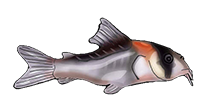What's the differance?
What's the differance?
How can I tell the differance between the Long fin Albino bristle nose pleco and the regular fin Albino bristlenose pleco. Now I know the answer seems ovious but they are about 1.5" to 2" in length and they all seem the same. I have them in the same tank but they all look so similar that it's hard for me to tell. When I put them in the tank together the long fin seemed a little whiter in color but now they are taking on the same shade. I'am sure once they get older I could tell them apart but I am afraid to move them to other tanks right now. Is there and difference that I could look for to tell them apart?
- medaka
- Expert
- Posts: 968
- Joined: 23 Dec 2003, 23:55
- I've donated: $20.00!
- My articles: 5
- My images: 65
- My cats species list: 3 (i:0, k:1)
- Spotted: 28
- Location 1: Runcorn.
- Location 2: Cheshire.UK
- Interests: Asiancatfish/Hypans/corys
- MatsP
- Posts: 21038
- Joined: 06 Oct 2004, 13:58
- My articles: 4
- My images: 28
- My cats species list: 117 (i:33, k:0)
- My aquaria list: 10 (i:8)
- My BLogs: 4 (i:0, p:164)
- Spotted: 187
- Location 1: North of Cambridge
- Location 2: England.
Long fins should show even when they are relatively small. 1.5-2" total length should be obvious which ones are long-finned, because the fins should be almost half the length of the fish, whilst the normal finned ones would have fins that are about a quarter of the fish's length. If it's not this obvious, then you probably haven't got proper long-finned version. Put it another way: Long fins are twice as loong as the normal fin, or it's not a proper long-fin.
--
Mats
--
Mats
- MatsP
- Posts: 21038
- Joined: 06 Oct 2004, 13:58
- My articles: 4
- My images: 28
- My cats species list: 117 (i:33, k:0)
- My aquaria list: 10 (i:8)
- My BLogs: 4 (i:0, p:164)
- Spotted: 187
- Location 1: North of Cambridge
- Location 2: England.
No, there shouldn't be any body-markings that are different, as it's the same species of fish, just that (like albinism) they have been bred to produce long fins (which is a genetical "disorder" which happens, most likely, through inbreeding - and long fins aren't unique to bristlenoses, many different fish have long fins - gold-fish would be the obvious example, but also Betta splendens, Angel's, and other fish have been bred to produce long fins).
This genetic disorder is independent of other genetical features...
Even with clamped fins, you should be able to tell the difference, I would say. Long fins are difficult to hide...
If nothing else, just catch one and decide when it's caught if it stays or goes [When caught or otherwise frightened, a natural reflex is to lock all fins in extended position]. They aren't particularly fragile fish, so should cope with being caught and released again without too much stress... Mine have moved several times in the last year, and still doing great (I move the female out of the breeding tank to prevent overbreeding, just as an example. She's in the big tank for the third time in the last year, so have moved five times in total).
--
Mats
This genetic disorder is independent of other genetical features...
Even with clamped fins, you should be able to tell the difference, I would say. Long fins are difficult to hide...
If nothing else, just catch one and decide when it's caught if it stays or goes [When caught or otherwise frightened, a natural reflex is to lock all fins in extended position]. They aren't particularly fragile fish, so should cope with being caught and released again without too much stress... Mine have moved several times in the last year, and still doing great (I move the female out of the breeding tank to prevent overbreeding, just as an example. She's in the big tank for the third time in the last year, so have moved five times in total).
--
Mats




